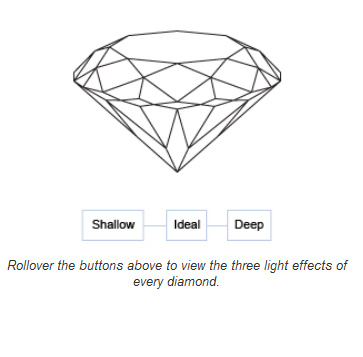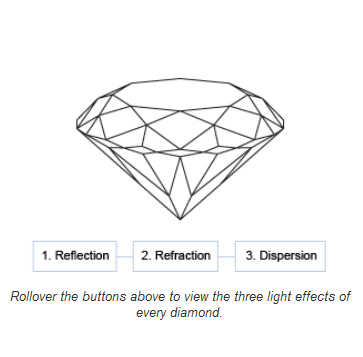Diamond Cut
The cut of the diamond is one of the 4Cs of diamond quality (and therefore price) along with carat (weight), clarity and color. Contrary to popular opinion, the cut of a diamond does not refer to its actual shape. Rather, cut refers to the way in which the gem has been prepared for polishing. A high-quality cut showcases the diamond wonderfully well, ensuring its brilliance and clarity is maximized. In contrast, a poor cut can make even a good quality diamond appear flawed and dull. The Diamond cut has some different characteristics, each of which can make a difference to the overall appearance of the diamond in its setting.
Cut Definitions
A diamond’s cut is an integral factor in determining its brilliance and fire. Even a flawless diamond will appear dull and muted if the cut is poor. When evaluating the cut of a diamond, there are some core characteristics that should be considered:
Depth & Depth Percentage
The depth of the diamond is simply how deep it is; depth percentage is probably a more useful value, as this refers to the depth of the stone divided by the width. The ideal depth percentage varies depending on the shape of the diamond and its cut. For example for oval-cut diamonds the ideal depth percentage is between 59-62%; for round diamonds, a good depth percentage would be around 59.5 to 61.9%. An optimal depth percentage allows the largest level of light to be reflected from the diamond, enhancing its brilliance.
Table & Table Percentage
The table of a diamond is the largest facet of the stone. It is normally found on the top surface of the stone and is flat, like a table. The table percentage is calculated by dividing the width of the table by the overall width of the gem. The table percentage helps to estimate how much light will be reflected from the big, table facet onto the lower, smaller facets. For most shapes and cuts of stone, a table percentage of between 54% and 60% is acceptable.
Measurements
Measured in millimeters, the measurements of a diamond’s length, width, and height are used to evaluate the symmetry and quality of its cut.
Proportions
A diamond’s proportions, a measure of the number and size of facets and its overall length and width, are integral in determining the quality of its cut. When a diamond is cut with the ideal proportions for its shape, it will reflect more light out of the top, resulting in higher levels of fire and brilliance. A poorly-cut diamond with incongruous proportions will allow light to escape out the bottom and sides, resulting in a dull, dark appearance.
The Crown
The crown is simply the top of the diamond. It includes the table as well as the facets which surround the table. The crown goes down to the girdle, which is the widest part of the diamond.
Girdle
This is the part of the diamond where the circumference is greatest. The perimeter of the stone, the girdle marks the end of the crown and the commencement of the lower part of the diamond (the pavilion).
Pavilion
As indicated earlier, this is the lower part of the diamond and stretches from the girdle down to the culet.
Facet/Faceting (Step-cut/brilliant-cut)
With modern diamond-cutting techniques, there are two common methods of cutting facets, each with its own unique light reflection properties:
Step-cut faceting
In this approach, the facets are elongated and placed in rows to simulate a mirrored staircase.
Brilliant-cut faceting
This technique creates triangular-shaped facets that face outwards from the center of the diamond.
Polish, symmetry and cut grade
The way in which a diamond is polished has a considerable influence on its value as well as its appearance. The best diamonds benefit from a symmetrical shape and a high degree of polishing, which leaves every surface of the stone as smooth and blemish free as possible. It is worth noting that well-polished gems look much better than those who have been poorly treated, even if the original gem was superior in the latter case. The symmetry and polish of the diamond are assessed by a trained gem professional, who assigns it a specific grade.

Cut & Value
The quality of a diamond’s cut has a significant impact on its value. A well-cut stone sacrifices more of the rough diamond during the cutting process, resulting in a higher market value. It will also exhibit better light reflecting properties, exuding greater fire and brilliance. Improperly cut diamonds will have less visual appeal and a decreased value. To ensure the best value, look for a certified diamond with polish and symmetry ratings of ‘Good’ or better.
Culet
The smallest facet of a diamond, the culet is located at the very bottom of the stone. If the diamond ends in a point, the diamond grading report will show a value of ‘None’ for the culet designation. This small facet was originally intended to protect the diamond’s pavilion, although today’s settings are usually strong enough to render it unnecessary.
Cut & Depth
It’s the cut of a diamond that determines how much light is reflected back to the wearer, directly impacting its brilliance and fire. Diamonds are generally categorized into three main types of cuts:
Shallow cut
Although a shallow cut diamond will create the illusion of a larger stone, it allows light to escape out the sides instead of reflecting off the top, creating a lack of brilliance and sparkle.
Ideal cut
If you’re seeking a high quality diamond that beautifully reflects light, this is the cut for you. This premier cut style is well-proportioned and carefully angled to achieve a luminous appearance.
Deep cut
This type of cut poorly reflects light, resulting in a dull, muted appearance.

Light’s Effect on a Diamond
There are many factors that determine a diamond’s brilliance, the most important of which is its ability to reflect light. As a diamond is moved through a light source, tiny flashes will be visible within the stone. Commonly known as sparkle, this is also referred to as scintillation, an effect of the stone’s reflection and refraction of light.
1. Reflection
When light enters the surface of a diamond, a portion of it is reflected out of the top.
2. Refraction
The remaining rays of light travel into the center of the diamond and bounce off its internal walls, an effect known as refraction.
3. Dispersion
As light exits the diamond, dispersion causes the white light to be separated into multiple colors. Some light will escape out the bottom and sides, and some will reflect out of the top of the stone. The light that is reflected is referred to as the ‘fire’ of the diamond.
